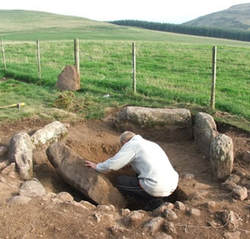Fieldwork module 2: Bronze Age burial

Circular burial mounds are amongst the most common prehistoric sites known from our region. In the uplands they are usually built of stone and are known as cairns; on lower ground they tend to be of soil and are referred to as barrows. When ploughed flat, as many are, they are often only detectable from the air, with a circular ditch (from which the mound material was originally excavated) showing up as a cropmark; in such cases the monuments are often classified as ‘ring-ditches’.
Several hundred barrows and cairns, the vast majority of known or presumed early Bronze Age date (between about 2,400 and 1500BC), are recorded on the Durham and Northumberland Historic Environment Records. Many of these are in isolation, while others are grouped together in cemeteries. Many were dug in the nineteenth century and the finds, including often very attractive burial urns and other grave goods, are now in museums throughout the region and elsewhere (e.g. the British Museum). These monuments hold many clues to the religious beliefs of the people who lived in our region four thousand years ago.
Several hundred barrows and cairns, the vast majority of known or presumed early Bronze Age date (between about 2,400 and 1500BC), are recorded on the Durham and Northumberland Historic Environment Records. Many of these are in isolation, while others are grouped together in cemeteries. Many were dug in the nineteenth century and the finds, including often very attractive burial urns and other grave goods, are now in museums throughout the region and elsewhere (e.g. the British Museum). These monuments hold many clues to the religious beliefs of the people who lived in our region four thousand years ago.